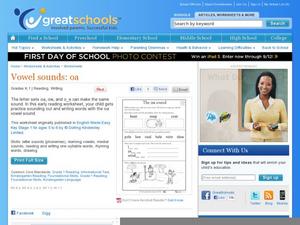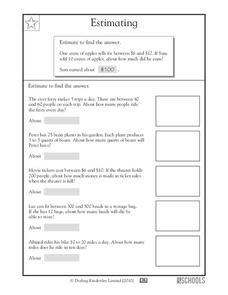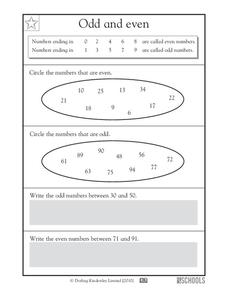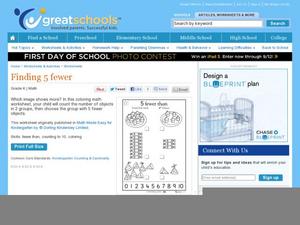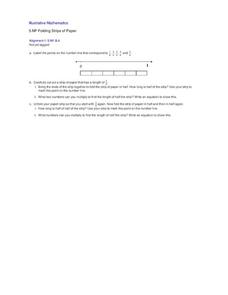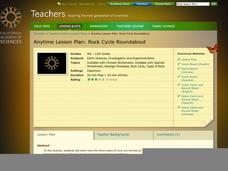Curated OER
Reading Comprehension: Thor and Sif
Expose your readers to the fascinating legends of Norse Gods Thor and Sif. They read a brief introduction about traditional stories and myths then read several paragraphs on these figures, marking unknown words as they go. Learners look...
Curated OER
Ordering Stories
What happened first? Learners examine four sets of images to sequence events using ordinal numbers. There is an example to get them started, and the first two have three pictures to organize. The final story is more challenging with four...
Curated OER
Syllables
How many syllables? This practice worksheet starts with a brief introduction on segmenting words, encouraging kids to say words aloud. They categorize 12 words into lists based on number of syllables: one, two, or...
Curated OER
The ee Sound
When two vowels take a walk, the first one does the talking! Scholars see this motto put to use as they study the /ee/ sound in various spelling patterns. Learners read a short introduction on this concept before reading several example...
Curated OER
The oa Sound
Explore spelling patterns with this multi-step worksheet featuring the /oa/ sound. Learners read a brief introduction explaining that this sound can be achieved by three different vowel combinations. They complete a different...
Curated OER
The oo Sounds
Investigate spelling patterns that make the /oo/ sound in this labeling worksheet. Scholars read a brief introduction explaining the different vowel pairings that make the long /oo/ sound, along with word examples. Then, they...
Curated OER
Location on a Grid
This grid features 15 animals, and scholars use a coordinate system to describe the location of each. The x-axis is labelled with letters and the y-axis with numbers, and they list the coordinate pairs beside the animal names below the...
Curated OER
Congruency
Which triangles are congruent? There are two sets of triangles here for scholars to examine in order to determine which of them are congruent. They use an example and explanatory introduction to guide them through this process. The first...
Curated OER
Reading Numbers
Teach number value to 20 through sets of objects. Young pupils use the number given for each of the four sets to determine how many should be colored in. How many are left? There is an addition box that has been left blank so scholars...
Curated OER
Coordinates
For beginning point plotters, these graphs give a good introduction. They examine a graph with shapes drawn onto it and each vertex labeled. There are 20 total, and scholars write the coordinates of each labeled point. All of these are...
Curated OER
Count How Many
How many now? Math beginners will benefit from this introduction to addition which doesn't even include addition symbols. They read number sentences in word form; however the numbers are in numeric form (for example, "1 and 2 more...
DK Publishing
Estimating
Through estimating, scholars are able to make these word problems simpler as they multiply to find approximate answers. Using an example as guidance, they solve five scenarios, each of which has space for learners to show their work. The...
Curated OER
Odd and Even
After you've introduced even and odd numbers give pupils this exercise for some independent practice. A brief introduction gives them the definition of even and odd by listing the ending numbers for both types. Be sure to reinforce the...
Curated OER
Factors of Numbers from 1 to 30
Finding factors is an integral skill on the road to fractions and algebra. Scholars write down a factor list for nine numbers up to 30. Next, they examine provided lists and circle the numbers that are factors of eight more numbers, also...
Curated OER
Factors of Numbers from 31 to 65
Finding factors is an integral aspect of multiplication. Although there are two examples here, they don't illustrate the process so you will still need to model this a few times for scholars. First, mathematicians list the factors for...
DK Publishing
5 Fewer Than
Before youngsters begin subtracting, give them this visual introduction focusing on the term fewer. They examine three pairs of party-themed object sets to determine which has five fewer than the other. After checking off the fewer...
DK Publishing
Learning 7 - Write the Number
Encourage number confidence by focusing on one number at a time; young counters examine the number seven, starting by tracing the numeral three times and printing a few more on their own. Next, they count three sets of flowers in an...
Curated OER
Long, Longer, Longest
This worm might be long, but can scholars draw an even longer worm? Focus on relative size as they draw a longer worm and then a longer necklace. Next, youngsters examine two sets of objects and check off the longest in an introduction...
Curated OER
Fast and Slow Motion
Explore the world of motion and force with an activity for kindergarten and first grade. After determining how people can make balls or bikes move slower, kids use a cardboard tube and a marble to experiment with motion and speed. A...
Curated OER
Exploring Owls
What can young scientists discover from dissecting an owl pellet? Explore the owl food chain, beginning with an introduction to these predatory birds. Suggested strategies here include creating a podcast and purchasing a poster, however...
Curated OER
Verbals: They look like verbs...but they're not!
Did you know there are three types of verbals? Do you even know what a verbal is? Provide your class with this brief introduction! Participles, infinitives, and gerunds are all introduced, and examples are given. Pair this with a...
Illustrative Mathematics
Rainfall
Ideal for use as an introduction to the idea of inverse functions, this activity investigates rainfall as a function of time. Learners use the data displayed in a table of values to analyze the function and its inverse, including why the...
Curated OER
Folding strips of paper
Fifth graders need concrete experiences to introduce a unit on multiplying fractions by fractions. A strip of paper is used to create a number line and represent 5/6. It is folded first in half, and then in quarters. After unfolding,...
California Academy of Science
Rock Cycle Roundabout
After a basic introduction to the rock cycle and the three main types of rocks, young geologists can deepen their understanding of how rocks change through a fun learning game. Based on the characteristics and events shared by a reader,...
Other popular searches
- Introduction to Poetry
- Introduction to Fractions
- Introduction to Economics
- Introduction to Biology
- Introduction Paragraphs
- Introduction to Trigonometry
- Introduction to Holocaust
- Introduction to Genetics
- Introduction to Civics
- Introduction to Powerpoint
- Introduction to Sociology
- Journalism Introduction




